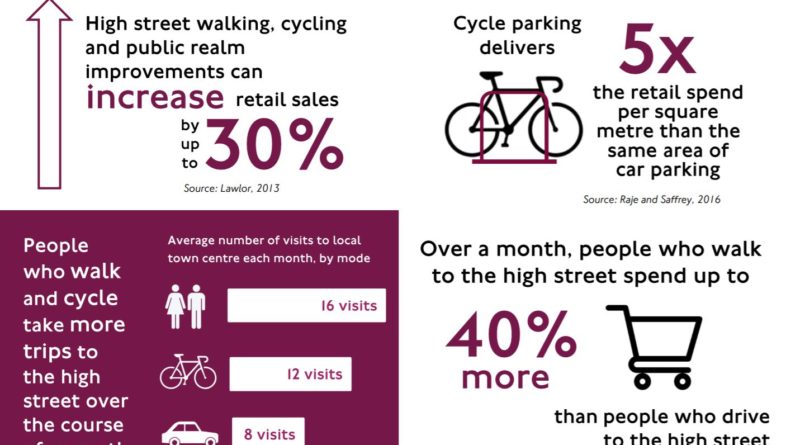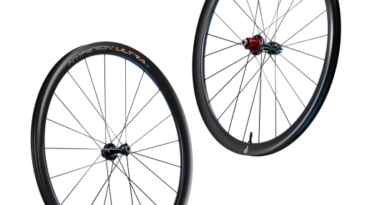TfL economic benefits of cycling paper a home run for investment case
A newly-released 29-page document from Transport for London has made a solid case for investment in active travel, citing wide-ranging economic benefits of cycling.
Drawing on a large pool of independent research the paper’s headline stats include the revelation that improving walking and cycling conditions can boost nearby retail trade by up to 30% (Source: Lawlor, 2013).
Citing a 2016 Raje and Saffrey study, TfL further outline that compared to car parking spaces cycle parking delivers five times the retail spend per square metre of space taken.
The paper further outlines the economic benefits of cycling with examples of increased sales tax revenues in Los Angeles post protected lane installation, as well as Copenhagen Cycle Account data that showed two thirds of revenue came from customers choosing active travel means.
Those arriving either by bike (12 visits) or on foot (16 visits) are said to visit much more than those in cars (8 visits). Those who walk tend to spend more, around 40% more, according to TfL’s own data.
The boon to business far from ends with increased footfall; the paper says that businesses also see walking and cycling conditions as key to retaining staff and boosting productivity, all the while reducing sickness rates by around 27%. This is worth some £128 million to the economy each year, according to data from a cited Grous 2011 study.
Sand through the city funnel, analysis of the flow of traffic has shown that 5% more people move at peak time through streets clad with cycle lanes.
At a time when London’s population is said to be growing by six residents per hour it is estimated that congestion will soon cost the capital’s economy an eye-watering £9.5 billion annually. 
Pulling data from Blackfriars Bridge, where segregated infrastructure now exists, it is shown that the cycle lane now moves 1,938 people per hour during the morning peak, while the adjacent road moves less at 1,542.
Bucking a downward trend for retail vacancy and adding weight to the notion retailers do better with cycling infrastructure nearby, those streets that have it in place have 17% lower retail vacancy rate. On the downside for those running the businesses, retail rental values on such streets rose by 7.5%.
When surveyed, shops over-estimated how many of their customers arrived by car. According to the data businesses surveyed on Lea Bridge Road believed around 63% of customers drove in, but visitors countered with only 20% telling researchers that’s how they arrived. Interestingly, retailers guessed correctly that around 12% came by bike, though they underestimated how many walked by 15%.
Social cycles
The social benefits of active travel, according to the Carmona, 2018 study cited, saw a 216% spike in people stopping in town centres to socialise.
Back in the office and surveys have shown that 73% of people who cycle to work tend to feel more productive at work.
The former CEO of Microsoft is quoted within TfL’s paper as saying “our network of offices will be knitted together by cycle superhighways. We look forward to using the protected routes to help us attract and retain the people we need to thrive.”
Within Business Improvement Districts (BIDS) as many as 85% of people surveyed responded positively to the notion that safe cycling access was important for the area. What’s more, businesses themselves are prioritising such access when looking for property, according to the British Council of Offices.
“Cycling is a fundamental part of the future city and has been a critical factor in Google’s decision to invest in King’s Cross and London. Cycling has an important role to play in attracting and retaining talent,” added Dan Conley, the former CEO of Google UK.
Return on investment 
Towards the end of the paper we are shown the cost to benefit ratio of the investment to date, which for cycling clocks in at 13:1 – that’s £13 for every £1 spent.
A Newson and Sloman study cited on the same page outlines that cycling now contributes more than three times to the UK economy than the steel industry, registering some £5.4 billion in direct benefits.
This is before health benefits are considered. Signing off, the paper says that “if every Londoner walked or cycled for 20 minutes each day the saving in treatment costs to the NHS would be approximately £1.7 billion over 25 years. This is largely down to forecast reductions in Type 2 Diabetes (35 to 50% down), depression (20 to 30% down), Alzheimer’s disease (25 to 35% down) and various cancers.
The TfL paper can be seen in full here. For a vastly larger dataset on the economic benefits of cycling, check in with our free library here.



